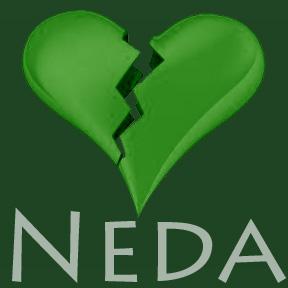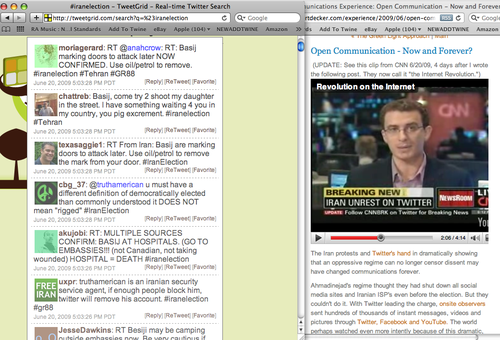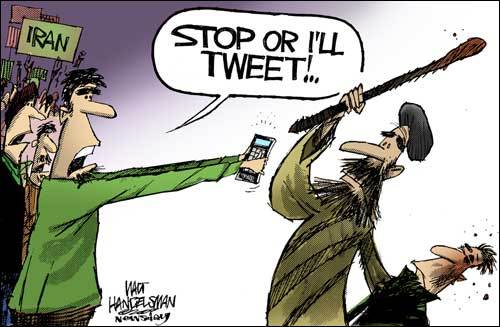 June 22, 2009 Youth culture is highly visual and iconic, no doubt about it. According to Graham Brown’s article, Youth in Iran, about 60% of the population in Iran is under 25, so it’s no surprise that the death in the streets of 26-year old “Neda” has become iconic very, very fast.
June 22, 2009 Youth culture is highly visual and iconic, no doubt about it. According to Graham Brown’s article, Youth in Iran, about 60% of the population in Iran is under 25, so it’s no surprise that the death in the streets of 26-year old “Neda” has become iconic very, very fast.
As students and global citizens rally using social media mobilization to protest the outcome of the Iranian election, the shift toward worldwide community and empathy toward human beings of all ages pours forth like tears in raw, real time. It’s readily apparent media’s mouthpieces have changed forever…
With multiple “ReTweets” of the uprising, mini-clips of handheld video streamed in citizen journalism style and auto-translation of Persian messages tearing down language barriers, clearly “we’re not in Kansas anymore, Toto”...Even if the web has turned into the ‘Emerald City’ of green.
The “Green Wall” of thumbnail photos on Twitter, Facebook profiles, and Paste Magazine’s “Iranicon Me” are highly visual, stimulating ways to show support en masse on a global scale…But as we enter these media conversations at lightening speed we need to carefully sharpen critical thinking skills and “teach our children well” to do the same.
That green tint should be accompanied by a red stoplight for kids to be able to answer basics like, “What’s happening in Iran right now?” or “Who IS Neda?” rather than bandwagoning current affairs into nebulous explanations that mirror the Beatles lyrics to Revolution.
The “click to help” crowd needs to balance motivation and emotion with historic background, knowledge, and context or else we’re at risk of seeing mass movements that take hold more like ‘memes’ than meaningful protests.
Sincere catalysts for change need to embrace substance over sound bites with students deep-diving in the data pool rather than splashing in the shallow end.
Since youth are particularly visual, and increasingly adults are too, I’ll turn over this post to my esteemed NextNow Collaboratory colleague Bonnie DeVarco (of Buckminster Fuller fame) to guide us through the arcs and edges of visual experience to “scale independent thought.”
Bonnie’s insightful “Six Degrees of Connective Intelligence” article crossposted here on Shaping Youth makes fascinating correlations that unleash the mind into “word clouds” and “TweetGrids” that map the future of our digital culture, monitoring multiple info searches in real time. She’s included a short one minute video clip of Kevin Bacon’s Six Degrees.org discussing the interconnectivity of us all and Network for Good’s involvement in same too…
So rather than get into the politics of the Iranian strife, we’ll focus on the media impact of the messaging and the altered state of ‘marketing’ a global cause…For all the kids that responded to my inquiry about Iran with angst, in “school’s out for summer” mode, Bonnie offers some highly VISUAL mental floss for when you’re ready to dive in the pool and start splashin’ in the deep end.
![]() Finally, this post is dedicated as a tribute to our NextNow collaboratory friends Laleh and Yassi, with high hopes that the megaphone of humanity will blend with the mapping power of Google Earth, SMS mobilization for safety, and smart phones for camcording to show us the way toward universal peace.
Finally, this post is dedicated as a tribute to our NextNow collaboratory friends Laleh and Yassi, with high hopes that the megaphone of humanity will blend with the mapping power of Google Earth, SMS mobilization for safety, and smart phones for camcording to show us the way toward universal peace.
Six Degrees of Connective Intelligence
by Bonnie DeVarco
This summer solstice weekend, the conversation grids of Twitter and other social media networks brightly light up to align an international community of human revolutionaries – in solidarity with Neda’s compatriots worldwide.
At this very moment, millions are uniting with their brothers and sisters in the streets of Iran. From thousands of miles away, the Internet brings information immediately between continents and countries as if from the same local community, unencumbered by spatial constraints and political borders.

The hashtags, #IranElection and #Neda become top trending topics on Tweetgrid, linking the Twitter community together to share the latest news minute by minute.
Some offer links to the newest updated videos or blog posts, others share Google maps of Embassy locations for the wounded, others, through rapid access to indelible images and video streams, share the immediacy of their heartbreak over the victims – sons and daughters of our international online community.
A borderless community grid of hearts and minds strive for global transparency and share their hopes for freedom with a human country at the crossroads – all in real time. Even our most fleet footed news portals such as CNN and the BBC, denied access to direct information and media feeds, are turning to yesterday’s disruptive social technologies to lend a hand in spreading the word.
And soon, we will have, as we had with President Obama’s inaugural “tweetmap”, new visualizations of this rapid fire ‘global conversation.’ Mapped from data trails of these posts, rendered in seamless, synthetic relief, we will soon have a new dynamic map that puts a vision to this important milestone in the history of the connective mind.
Jeff Clark, also known as Neoformix to visualization buffs, has already provided a word cloud map to this fleeting territory in his PhraseNet visualization. This one (above) is based on 141,000 characteristic tweets from the Iran election.
This is the beginning of the streaming, conversational network of the realtime global community. Let’s think about it as a small world network.
Most have already heard about the six degrees of separation – how everyone on the planet is connected to everyone else by no more than six degrees.
Here is a condensed evolution of small world theory in six steps.
This is the small world network: (w/illustrations/graphics)
1.) that was discovered and named by social psychologist Stanley Milgram in 1967, who postulated that networks of clusters connected to other clusters with very few bridges…
2.) whose connections were popularized by the Six Degrees of Kevin Bacon game, “The Oracle of Bacon”…
3. whose complex systems algorithm was proposed by Watson Strogatz, initiating a new “science of networks”…
4. whose collective dynamics were empirically proven by scientist, Duncan Watts (who, with Strogatz, proved exactly how the six degrees model worked in all types of networks)…
5. Whose science of scale-free networks was advanced by physicist Albert-Laszlo Barabasi who proved their distribution follows a specific power law, and this common blueprint can be seen in a vast array of networks – from intra-cellular protein networks to human social networks…
6. whose dynamics were put to practical use through cognitive scientist Alessandro Vespignani’s research, applying network theory of computer viruses to human behavior in order to map how patterns of global transport networks can help us quickly respond to pandemic outbreaks.
Impact of Air Travel on the Global Spread of Infectious Diseases, by Vespignani, et.al.
A brief history of a profound new way of thinking.
Small world theory shows that we are all nodes in a complex network of relationships binding each human being to every other by a maximum of only six degrees.
This proven theory is now a game changer for humanity, rather than a game.
 The Green revolution of Iran, where the heart of Neda is linked to the hearts of every one of us, is now a human revolution. And its outcome beckons each of us to willingly play our part for a better humanity – and to see how we already make a difference.
The Green revolution of Iran, where the heart of Neda is linked to the hearts of every one of us, is now a human revolution. And its outcome beckons each of us to willingly play our part for a better humanity – and to see how we already make a difference.
With new ways of thinking and “seeing”, we can begin to tell our condensed histories, and to envision new outcomes.
Each and every one of us must understand all too much in all too short a time. The survival of our species depends on it. And visualization technologies that help us do this are our most important tools for shared knowledge and global self-reflexivity.
A surprising initiative to break out of the institutions that hold back this many-to-many communication landscape is emerging from within the institutions themselves. A call and manifesto vastly different than those that came before.
Digital Humanities Seminar in Second Life
As a result of the year long, “Mellon Seminar 2008-09: What is(n’t) Digital Humanities?” at UCLA’s Digital Humanities and Media Studies Lab, a manifesto about the rapidly changing, open source nature of knowledge was developed: The Digital Humanities Manifesto 2.0.
Co-written by Todd Presner of UCLA and Jeffrey Schnapp of Stanford University, this document asks us to listen to what our symbiotic relationship with accelerated communication technologies mirrors back to us about the rapidly changing shape of humanity. Calling itself “an array of convergent practices,” the manifesto is a call to arms, urging us, “Lets get our hands dirty.” Its final paragraph states:
“…our vision is of a world of fusions and frictions, in which the development and deployment of technologies, and the sorts of research questions, demands, and imaginative work that characterize the arts and Humanities merge.”
We must learn to see the relationships between people, knowledge, ideas and activism – and to express and curate them through new technology-mediated art forms.
As Twitter streams become maps to new global conversations, fresh perspectives of our collective history are also greatly needed. And many are already available. New maps of science offer us satellite views of humanity’s knowledge based on decades of citations indices. New clickstream maps of knowledge show us how the humanities and social sciences already cross-fertilize each other in ways we never thought were possible.
—Bonnie DeVarco
From mapping science and the synthesis of the mind to visual complexity, clickstreams, and Salvador Dali, I’ll send you over to Bonnie DeVarco’s excellent treatise for Part 2.
I can almost hear Bonnie’s voice depicting these “six degrees of connective intelligence,” with Eileen Clegg of Visual Insight bringing it to life in bright marker, sharing:
- Human stories become real time conversations documented on the social web
- that link humans into complex conversational and activist networks
- that leave information trails and data tracks we can turn into maps, artworks and visualizations
- that we can draw from to synthesize new information
- to tell ourselves richer, more comprehensive narratives and stories
- to gain and share a higher level of collective wisdom
Meanwhile, I urge everyone to think about the media megaphone of humanity. The mapping power of Google Earth. The SMS uses of prevention, evacuation or formation of ‘smart mobs.’ The eyes of the world watching events unfold. The power of imagery and “photos that changed the world” is everpresent to any scholar of the human condition.

Students have always been integral in media mindshifting…pondering rhetoric, questioning authority, and unearthing the “why did we get here” and “what can we do about it”…
Just as “Neda” in Iran in 2009 is iconic, so was the lone Tiananmen Square student facing off against tanks in 1989, or rewinding twenty years to student anti-Vietnam protests in 1969…
The images are forever seared into our mental relays, even if kids today weren’t even born yet.
The difference now is we’re creating those images ourselves…with the words, distribution channels, and individual media megaphones to match.
Visual Credit Editorial cartoonist Walt Handelsman, Newsday via Boston Globe









Great article, Amy! It’s amazing to see what social media is doing in countries like Iran. Makes it much tougher to keep the media spin “under control.” It will be interesting to see if the current regime is able to keep dissenting opinions at bay with violence or if this is just the beginning of a real youth uprise.
Hi Melanie, yes, control is in the eye of the beholder indeed…Of course, evasion tactics and techniques to cope with the backlash could end up saving kids’ lives in an uprising, too; these were just posted…which hopefully social media will ‘tweet’ to protect all:
http://www.iranian.com/main/node/69429
hey amy i’m from tehran and want to thank you for your consideration.
Pleasure to virtually handshake, Pouyan; how you hangin’ in there amidst the chaos?
.-= Amy Jussel´s last blog ..The Laramie Project: Using Media to Teach Tolerance 10 Years Later =-.